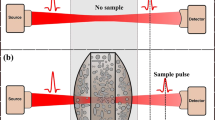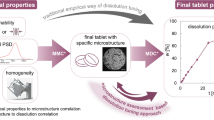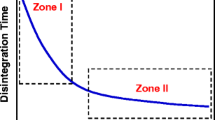Purpose
Several phenomena in tablets indicate that an inhomogeneous pore distribution is formed during the compaction process. Examples are lamination and the capping of corners. In order to gain an understanding of the relation between structure and compact properties, analyzing the structure in a location dependent manner would be extremely useful. Our aim was to visualize and to quantitatively analyze the pore distribution in compacts.
Methods
This was done by embedding a cubic (sodium chloride) compact with polymer, allowing the compact to be cut without disrupting the structure. By doing so, it was possible to make scanning electron microscopic images from different angles at different locations in the compact. These images were made binary with a two-means cluster algorithm (Isodata) after which the porosity could be calculated. Counting the number of transitions from the pixels in the pores to the pixels in the sodium chloride particles in two perpendicular directions allows us to construct a measure for the anisotropic connectivity of the particles.
Results
The results show an increase in porosity toward the bottom of the compact and showed a preferred orientation of the pores in the direction of compression.
Conclusions
The proposed method is suitable for analyzing the pore distribution quantitatively and for evaluating anisotropy.







Similar content being viewed by others
Abbreviations
- GMA:
-
glycol methacrylate
- SEM:
-
scanning electron microscope
References
W. H. Duckworth (1953) ArticleTitleDiscussion of Ryshkewitch paper by Winston Duckworth J. Am. Ceram. Soc. 36 68
B. Veen ParticleVan K. Voort Maarschalk ParticleVan der G. K. Bolhuis M. Gons K. Zuurman H. W. Frijlink (2002) ArticleTitleThe influence of particles of a minor component on the matrix strength of sodium chloride Eur. J. Pharm. Sci. 16 229–235 Occurrence Handle10.1016/S0928-0987(02)00105-7 Occurrence Handle12208452
A. M. Juppo (1995) ArticleTitleRelationship between breaking force and pore structure of lactose, glucose and mannitol tablets Int. J. Pharm. 127 95–102 Occurrence Handle10.1016/0378-5173(95)04203-2
T. Ando H. Yuasa Y. Kanaya K. Asahina (1983) ArticleTitleStudies on anisotropy of compressed powder. III. Effects of different granulation methods on anisotropy, pore size and crushing strength of tablets Chem. Pharm. Bull. 31 2045–2054 Occurrence Handle6640794
S. Malamataris T. Hatjichristos J. E. Rees (1996) ArticleTitleApparent compressive elastic modulus and strengths isotropy of compacts formed from binary powder mixes Int. J. Pharm. 141 101–108 Occurrence Handle10.1016/0378-5173(96)04621-2
G. Alderborn C. Nystrom (1984) ArticleTitleRadial and axial tensile strength and strength variability of paracetamol tablets Acta Pharm. Suec. 2 1–8
J. M. Newton G. Alderborn C. Nystrom (1992) ArticleTitleA method of evaluating the mechanical characteristics of powders from the determination of the strength of compacts Powder Technol. 72 97–99 Occurrence Handle10.1016/S0032-5910(92)85013-L
A. M. Bouwman M. J. Henstra D. Westerman J. T. Chung Z. Zhang A. Ingram J. P. K. Seville H. W. Frijlink (2005) ArticleTitleThe effect of the amount of binder liquid on the granulation mechanisms and structure of microcrystalline cellulose granules prepared by high shear granulation Int. J. Pharm. 290 129–136 Occurrence Handle10.1016/j.ijpharm.2004.11.024 Occurrence Handle15664138
L. Farber G. Tardos J. N. Michaels (2003) ArticleTitleUse of X-ray tomography to study the porosity and morphology of granules Powder Technol. 132 57–63
A. M. Juppo (1996) ArticleTitlePorosity parameters of lactose, glucose and mannitol tablets obtained by mercury porosimetry Int. J. Pharm. 129 1–12 Occurrence Handle10.1016/0378-5173(95)04201-6
B. Veen Particlevan K. Voort Maarschalk Particlevan der G. K. Bolhuis M. R. Visser K. Zuurman H. W. Frijlink (2002) ArticleTitlePore formation in tablets compressed from binary mixtures as a result of deformation and relaxation of particles Eur. J. Pharm. Sci. 15 171–177 Occurrence Handle10.1016/S0928-0987(01)00216-0 Occurrence Handle11849914
H. Vromans A. H. Boer ParticleDe G. K. Bolhuis C. F. Lerk K. D. Kussendrager H. Bosch (1985) ArticleTitleStudies on tableting properties of lactose. Part 2. Consolidation and compaction of different typesof crystalline lactose Pharm. Weekbl., Sci. 7 186–193
P. Sriamornsak N. Thirawong (2003) ArticleTitleUse of back-scattered electron imaging as a tool for examining matrix structure of calcium pectinate Int. J. Pharm. 267 151–156 Occurrence Handle10.1016/j.ijpharm.2003.08.005 Occurrence Handle14602393
http://www.ph.tn.tudelft.nl/DIPlib (accessed 3/23/04).
T. W. Ridler S. Calvard (1978) ArticleTitlePicture thresholding using an iterative selection method IEEE Trans. Syst. Man Cybern. 8 630–632
J. C. Russ R. T. Dehoff (2000) Practical Stereology Kluwer Academic/Plenum New York 56–61
N. Ozkan B. J. Briscoe (1997) ArticleTitleCharacterization of die-pressed green compacts J. Eur. Ceram. Soc. 17 697–711 Occurrence Handle10.1016/S0955-2219(96)00090-8
D. Train (1956) ArticleTitleAn investigation into the compaction of powders J. Pharm. Pharmacol. 8 745–761 Occurrence Handle13368074
J. Nam W. Li J. L. Lanutti (2003) ArticleTitleDensity gradients and springback: environmental influences Powder Technol. 133 23–32 Occurrence Handle10.1016/S0032-5910(03)00083-4
I. C. Sinka S. F. Burch J. H. Tweed J. C. Cunningham (2004) ArticleTitleMeasurement of density variations in talbes using X-ray computed tomagraphy Int. J. Pharm. 271 215–224 Occurrence Handle10.1016/j.ijpharm.2003.11.022 Occurrence Handle15129988
B. J. Briscoe S. K. Sinha (1997) ArticleTitleDensity distributions characteristics of green ceramic compacts using scratch hardness Tribol. Int. 30 475–482 Occurrence Handle10.1016/S0301-679X(97)00010-8
Author information
Authors and Affiliations
Corresponding author
Rights and permissions
About this article
Cite this article
Wu, Y.S., Frijlink, H.W., van Vliet, L.J. et al. Location-Dependent Analysis of Porosity and Pore Direction in Tablets. Pharm Res 22, 1399–1405 (2005). https://doi.org/10.1007/s11095-005-5280-x
Received:
Accepted:
Published:
Issue Date:
DOI: https://doi.org/10.1007/s11095-005-5280-x




